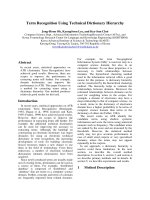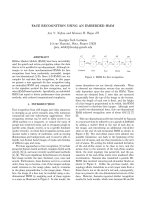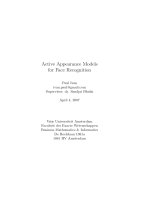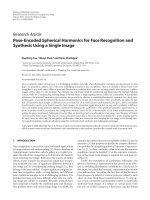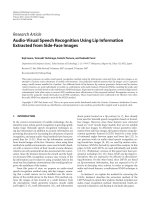report technical writing andpresentation topic face recognition using computervision for security system
Bạn đang xem bản rút gọn của tài liệu. Xem và tải ngay bản đầy đủ của tài liệu tại đây (1.45 MB, 18 trang )
<span class="text_page_counter">Trang 1</span><div class="page_container" data-page="1">
HANOI UNIVERSITY OF SCIENCE AND TECHNOLOGY
<b>SCHOOL OF ELECTRICAL & ELECTRONIC ENGINEERING</b>
<b>TECHNICAL WRITING ANDPRESENTATION</b>
<b>FACE RECOGNITION USING</b>
<b>COMPUTERVISION FOR SECURITY SYSTEM</b>
Student: VU MINH HUYStudent ID: 20203721Class: ET 05 - K65
Supervisor: NGUYEN TIEN HOA, Ph.D
Ha Noi, December 29, 2022
</div><span class="text_page_counter">Trang 2</span><div class="page_container" data-page="2">2.1 Fundamental of deep learning . . . . 2
2.2 CNN . . . . 2
2.3 Face recognition component . . . . 3
2.3.1 Principal Component Analysis . . . . 3
2.3.2 Classification of face images . . . . 4
2.3.3 Anti-spoofing approach . . . . 4
2.3.4 HAAR fopr face detection . . . . 4
<b>CHAPTER 3. APPLICATIONS OF FACE RECOGNITION IN COMMONSECURITY SYSTEM6</b>3.1 Allications and example . . . . 6
FA-4.2.1 Security Through Biometric Authentication . . . . 8
4.2.2 Automated Image Recognition . . . . 8
</div><span class="text_page_counter">Trang 3</span><div class="page_container" data-page="3">4.2.4 Human-Computer Interaction . . . . 9
4.3 Disadvantages and limitations of facial recognition system . . . . 9
4.3.1 Issues About Reliability and Efficiency . . . . 9
4.3.2 Further Reports About It Reliability . . . . 9
4.3.3 Concerns About Racial Bias . . . . 9
4.3.4 Issues with Privacy Laws . . . . 9
</div><span class="text_page_counter">Trang 4</span><div class="page_container" data-page="4"><b>LIST OF SIGNS AND ABBREVIATIOMS</b>
</div><span class="text_page_counter">Trang 5</span><div class="page_container" data-page="5"><b>LIST OF FIGURES</b>
Hình 2.1 A Venn diagram describing deep learning as a subfield of machine
learning which is in turn a subfield of artificial intelligence . . . . 3
Hình 2.2 The general idea of the face recognition system . . . . 3
Hình 2.3 The detailed procedure of PCA algorithm . . . . 4
Hình 4.1 the implementation of the real-time . . . . 8
</div><span class="text_page_counter">Trang 6</span><div class="page_container" data-page="6">espe-to the forenamed matter is a face recognition system using computer vision for the curity system, which can descry intruders in defined or high- security areas and helpminimize mortal error. A face recognition system is the verification system to find aperson’s identity through biometric system. Face recognition has come a popular sys-tem presently for multitudinous operations, analogous as phone unlock systems, lawlessidentification, and indeed home security systems. Because of general curiosity and in-terest in the matter, the author has excavated to find out how machine vision recognizeshumans and its operations in common security systems.
</div><span class="text_page_counter">Trang 7</span><div class="page_container" data-page="7"><b>se-CHAPTER 1. INTRODUCTION</b>
Face recognition presents a challenging problem in the field of image analysis andcomputer vision. Facial recognition application is utilized for safety purposes. Govern-ing buildings and businesses alike harness the force for thwarting crime and providingjust trusted employees on their assumptions. Combining that with the efficient safetyteam keeps in terms of business finances, and creates a highly operating security sys-tem. However, using the technology for nothing but protection could be silly, as it will doa lot more. Facial recognition technology is quickly spreading, as it is starting to followareas like education, family safety, and personal industries. The failure of credit carddata and social security figures led to a broad fear, and had millions of people doubtingcontemporary cyber security practices. Facial recognition is the most guaranteed way tokeep this from occurring again.
This report contains five sections:
• The first chapter describes the problem are commonly security system facing now.• Chapter 2 presents an overview of the face recognition system.
• The third chapter depicts applications of face recognition in common security tem.
sys-• Finally, the last chapter presents the advantages and disadvantages of each facialrecognition security system.
</div><span class="text_page_counter">Trang 8</span><div class="page_container" data-page="8"><b>CHAPTER 2. OVERVIEW OF FACE RECOGNITION SYSTEM.</b>
Face recognition is part of computer vision. Face recognition[1] is used to fying a person in biometric method based on image on their face. A person is identifiedthrough biological traits. Human eyes can easily recognize people by simply looking atthem but the concentration span for human eyes has its limit. Hence, a computerizedmethod is invented to perform face recognition. Face recognition [2] includes the op-erations of automatically etecting followed by verifying a person from either picture orvideo
<b>identi-2.1 Fundamental of deep learning</b>
Deep learning is a subfield of machine learning, which is, in turn, a subfield ofartificial intelligence (AI) 2.1. The central goal of AI is to provide a set of algorithmsand techniques that can be used to solve problems that humans perform intuitively andnear automatically, but are otherwise very challenging for computers. A great example ofsuch a class of AI problems is interpreting and understanding the contents of an image-this task is something that a human can do with little-to-no effort, but it has proven to beextremely difficult for machines to accomplish. While AI embodies a large, diverse setof work related to automatic machine reasoning (inference, planning, heuristic, etc.) themachine learning subfield tends to be specifically interested in pattern recognition andlearning from data.
Artificial Neural Networks (ANNs) are a class of machine learning algorithmsthat learn from data and specialize in pattern recognition, inspired by the structure andfunction of the brain. As I’ll find out, deep learning belongs to the family of ANNalgorithms, and in most cases, the two terms can be used interchangeably. In fact, youmay be surprised to learn that the deep learning field has been around for over 60 years,going by different names and incarnations based on research trends, available hardwareand datasets, and popular options of prominent researchers at the time.
<b>2.2 CNN</b>
A Convolutional Neural Network (CNN) is a type if (ANNs) used in image nition and processing that is specifically designed to process pixel data. CNNs are pow-erful image processing, artificial intelligence (AI) that use deep learning to performboth generative and descriptive tasks, often using machine vison that includes imageand video recognition, along with recommender systems and natural language process-ing (NLP).
</div><span class="text_page_counter">Trang 9</span><div class="page_container" data-page="9"><b>recog-Hình 2.1A Venn diagram describing deep learning as a subfield of machine learningwhich is in turn a subfield of artificial intelligence</b>
<b>2.3 Face recognition component</b>
In the facial recognition component, the input face image is tested with the ing image in the database. Both training image and test image goes through the prin-ciple component analysis (PCA) feature extraction, which is then classified using theEuclidean distance classifier.2.2
<b>train-Hình 2.2The general idea of the face recognition system</b>
2.3.1 Principal Component Analysis
For feature extraction, PCA is chosen because it is good at reduction of dimensionwhere data is compressed. By representing high dimension data of face images withlower dimension data, it reduces the complication and intricacy of sorting the images ingroups. PCA defines original data with calculated eigenvectors and eigenvalues when itis projected onto a lower dimensional feature space. PCA captures the most distinctivedata component from the face image which helps in maximising between-class dataseparation[3] . The detailed procedure of PCA algorithm is described in 2.3
</div><span class="text_page_counter">Trang 10</span><div class="page_container" data-page="10"><b>Hình 2.3The detailed procedure of PCA algorithm</b>
2.3.2 Classification of face images
In this project, classification is performed by comparing the projection vectors ofthe training face images with the projection vector of the input face image based on theEuclidean distance classifiers between the faces classes and the input face image. Theclassifier computes the square root of distance between the coordinates of two objects2.3.3 Anti-spoofing approach
The anti-spoofing approach proposed in this system is by detecting blinking eyes.Eye blinking is detected from analysing one by one each sequence image to classify thestate of either opened eye or closed eye. The eye area is detected by Viola-Jones method,while the blinking of eyes are detected using Histograms of Oriented Gradients (HOG)as features and Support Vector Machines (SVM) as binary classifiers.
2.3.4 HAAR fopr face detection
For detecting the face, the HAAR Cascade algorithm is used in this paper. HAARcascade is one of the deep learning algorithms which can associate things. It is foundon the theory presented by PaulViola also Micheal Jones in their paper "Rapid ObjectDetection with a Boosted Cascade of SimpleFeatures."Thus, popularly known as theViola-Jones algorithm. It is based on a resemblance where acascade function is in-structed using to a great extent positive images also negative images. It also associatesthe things in many images. It has four stages: The algorithm has four stages:
</div><span class="text_page_counter">Trang 11</span><div class="page_container" data-page="11">• 1.Selection of HAAR features• 2.Creation of Integral Images• 3.Adaboost Training• 4.Cascading Classifiers
</div><span class="text_page_counter">Trang 12</span><div class="page_container" data-page="12"><b>CHAPTER 3. APPLICATIONS OF FACE RECOGNITION INCOMMON SECURITY SYSTEM</b>
Facial recognition is everywhere. What once started as an attribute specific to scifimovies is now a part of everyday life: we rely on facial recognition every time we unlockour phones(FACE ID), tag friends in a Facebook post, or go through customs.
Face regconition is also useful in human computer interaction, virtual reality, databaserecovery, multimedia, computer entertainment information security e.g. operating sys-tem, medical records, online banking, Biometric e.g. Personal Identification - Passports[4]
<b>3.1 Allications and example</b>
3.1.1 Face Identification
Face recognition systems identify people by their face images. Face recognitionsystems establish the presence of an authorized person rather than just checking whethera valid identification (ID) or key is being used or whether the user knows the secretpersonal identification numbers (Pins) or passwords. The following are example.
To eliminate duplicates in a nationwide voter registration system because there arecases where the same person was assigned more than one identification number. Theface recognition system directly compares the face images of the voters and does not useID numbers to differentiate one from the others. When the top two matched faces arehighly similar to the query face image, manual review is required to make sure they areindeed different persons so as to eliminate duplicates
3.1.2 Access Control
In many of the access control applications, such as office access or computer gon, the size of the group of people that need to be recognized is relatively small. Theface pictures are also caught under natural conditions, such as frontal faces and indoorillumination. The face recognition system of this application can achieve high accuracywithout much co-operation from user. The following are the example. Face recognitiontechnology is used to monitor continuously who is in front of a computer terminal. Itallows the user to leave the terminal without closing files and logging out. When theuser leaves for a predetermined time, a screen saver covers up the work and disables themouse & keyboard. When the user comes back and is recognized, the screen saver clearsand the previous session appears as it was left. Any other user who tries to logon withoutauthorization is denied.
</div><span class="text_page_counter">Trang 13</span><div class="page_container" data-page="13">lo-3.1.3 Security
Today more than ever, security is a primary concern at airports and for airlinestaff office, passengers and family. Airport protection systems that use face recognitiontechnology have been implemented at many airports around the world. Many familiesuse facial security systems to protect themselves and their children
</div><span class="text_page_counter">Trang 14</span><div class="page_container" data-page="14"><b>CHAPTER 4. ADVANTAGES AND DISADVANTAGES OFEACH FACIAL RECOGNITION SECURITY SYSTEM</b>
<b>4.2 Advantages</b>
<b>Hình 4.1the implementation of the real-time</b>
Central to the advantage of facial recognition is that it enables the computerizedand automated processing of biometric data based on the digital image or live video feedof a person for a variety of purposes or applications4.1.
4.2.1 Security Through Biometric Authentication
One of the benefits of facial recognition system centers on its application in rics. It can be used as a part of identification and access control systems in organizations,as well as personal devices, such as in the case of smartphones.
biomet-4.2.2 Automated Image Recognition
The system can also be used to enable automated image recognition capabilities.Consider Facebook as an example. Through machine learning and Big Data analytics,
</div><span class="text_page_counter">Trang 15</span><div class="page_container" data-page="15">or tagging to individual user profiles.4.2.3 Deployment in Security Measures
Similar to biometric application and automated image recognition, another tage of facial recognition system involves its application in law enforcement and securitysystems. Automated biometric identity allows less intrusive monitoring and mass iden-tification.
advan-4.2.4 Human-Computer Interaction
The system also supports virtual reality and augmented reality applications. Filtersin Snapchat and Instagram use both AR and facial recognition. In both VR and ARapplications, the system facilitates further human-computer interaction.
<b>4.3 Disadvantages and limitations of facial recognition system</b>
Despite the advantages and application, facial recognition system has drawbacksand limitations revolving around concerns over its effectiveness and controversial appli-cations. Take note of the following:
4.3.1 Issues About Reliability and Efficiency
A notable disadvantage of facial recognition system is that it is less reliable andefficient than other biometric systems such as fingerprint. Factors such as illumination,expression, and image or video quality, as well as software and hardware capabilities,can affect the performance of the system.
4.3.2 Further Reports About It Reliability
Several reports have pointed out the ineffectiveness of some systems. For example,a report by an advocacy organization noted that the systems used by law enforcementagencies in the U.K. had an accuracy rate of only 2 percent. Applications in London andTampa, Florida did not result in better law enforcement according to another report.4.3.3 Concerns About Racial Bias
A study by the American Civil Liberties Union revealed that the Rekognition nology developed by Amazon failed nearly 40 percent false matches in tests involvingpeople of color. In general, the system has been criticized for perpetuating racial biasdue to false matches.
tech-4.3.4 Issues with Privacy Laws
Alleged conflict with privacy rights is another disadvantage of facial recognition.In Illinois, for example, its Biometric Information Privacy Act requires affirmative con-
</div><span class="text_page_counter">Trang 16</span><div class="page_container" data-page="16">sent for companies to collect biometric data. The fact that the system enables less sive mass identification also translates to mass surveillance, which according to groups,is a violation of privacy rights.
</div><span class="text_page_counter">Trang 17</span><div class="page_container" data-page="17">In conclusion, face recognition can be applied for security purpose, such as accesscontrol, immigration verification and even criminal identification. In this paper, a se-curity system using machine vision for face recognition is developed using Viola-Jonesmethod to detect face, Principal Component Analysis (PCA) for feature extraction andEuclidean distance classifier. The integration of Internet of Things (IoT) with the systemis also proposed. The algorithm performs relatively well in terms recognition rate andcomputational time under controlled environment. The face recognition can be furtherimproved by increasing the training image and using 3D image processing where the riskof spoofing is hugely reduced.
</div>